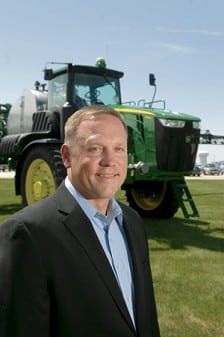Deere’s big leap
New 300,000-square-foot assembly building to create added capacity to build more high-volume equipment

Many Central Iowa residents assume that Deere & Co. builds tractors at its John Deere Des Moines Works in Ankeny.
Actually, the manufacturing facility is much more specialized. The 455-acre campus serves as a hub for the majority of the cotton harvesting equipment made by Deere, as well as a production facility for a broad array of crop-care equipment. And when a new 300,000-square-foot assembly building is completed next spring, it will be the most technologically advanced agricultural sprayer manufacturing facility in the world, said John Teeple, the factory manager.
“It’s going to be a leap forward for advanced manufacturing at the Des Moines Works,” he said.
The scope of Deere’s manufacturing operations in Ankeny – and the global customers that purchase the Iowa-made products – surprises many Iowans, Teeple said.
“When I start talking about customers in China, India and Brazil, people are absolutely shocked,” he said. “Depending on the product, anywhere from 10 percent to more than 50 percent of our products are exported. I think people are very surprised when they think about Ankeny, Iowa, and that this factory is the sole source for many of these products and that we export all over the world to 30 or more countries.”
Perhaps just as remarkable, the Ankeny plant has hired more than 600 additional employees in the past two years and doubled its production output in that same time frame. The plant now employs more than 1,500 production and maintenance workers and more than 500 salaried employees. The increased output is part of the company’s global strategy, announced in 2010, to double net sales to $50 billion by 2018.
“We’re bursting at the seams here,” said Teeple, a 16-year Deere employee who spent the first 12 years of his career at the company’s Waterloo tractor plant. “We’re doing everything we can to produce as many machines as possible with the infrastructure, assets and head count we have today. For the past two years, we’ve been in chasing-growth mode, which is exciting.”
Construction of a brand-new building at the Ankeny plant is significant, as it will be the first new stand-alone facility investment in a Midwest plant by Deere since 1979, Teeple said. It will also be the first new construction at the Ankeny factory, a former munitions plant that Deere purchased from the U.S. government following World War II.
“So the message that this delivers to our employees and the community is that we’re serious and committed to Ankeny,” Teeple said, “and we have very positive, long-term aspirations and outlook for the products we produce here.”
In December, the Ankeny City Council approved a development agreement with Deere that will provide a 15-year partial rebate of property taxes valued at up to $4.8 million. The Iowa Department of Transportation approved a grant of up to $6.24 million for the reconstruction of Irvindale Drive and improvements to Southwest Third Street to serve the factory. The Iowa Economic Development Authority board has approved up to $9.83 million in state tax credits for the project.
The company pledged to retain 400 existing jobs and invest a total of $85 million in capital improvements. Deere is conservative about projecting growth, which is why it chose to claim only job retention, and not new jobs, in its economic development incentive application with the state, Teeple said.
“When you’ve added 500 production and maintenance employees on the shop floor already, and over 100 salaried employees, you’re very, very cautious to commit to growth as part of the package,” he said. Additionally, “had we not built to expand, we would have had to move another major product somewhere else. So it really did come down to retention, from our standpoint.”
Global demand
World population growth and the significant demands on agricultural output that comes with it are driving ag machinery demand. The world’s population recently passed the 7 billion mark, and is expected to reach approximately 9.5 billion people by 2050.
In Deere’s earnings statement for its fiscal second quarter, which ended April 29, CEO Samuel Allen noted that the company has more than a dozen major expansion projects under way throughout the world, including seven new factories under construction in Brazil, China and India. In March, the company announced a $70 million expansion of its Waterloo tractor plant. Many experts believe that global agricultural output will need to double by 2050 to keep up with growing demand.
“Our extensive investments in new products and additional global capacity are moving ahead at an accelerated rate,” Allen said in an April press release. “These investments are essential to the success of our longer-term growth objectives, which we believe are firmly on track. They also put Deere in a sound position to respond to a rising global need for food, shelter, and infrastructure in the years ahead.”
Deere entered the multipurpose agricultural sprayer business in 1997. The Ankeny plant is one of only two in the world in which the company produces agricultural sprayers.
In addition to sprayers, the factory builds a broad range of seed drills, tillers, planters and harvesters. “Actually, this is the only place in the enterprise where John Deere’s entire equipment value chain is represented in one factory,” Teeple said. “We have products that prepare the land to plant; we have planting and seeding equipment; we have equipment that cares for the crops, that apply fertilizer, insecticide, herbicide; and we have products that harvest the crop – all in one factory.”
Ankeny has also been the home of Deere’s cotton harvesting equipment manufacturing since the facility opened in 1947.
The Ankeny plant will see a continued shift to production of larger, high-volume equipment, while production of smaller machines will be transferred to other locations, Teeple said. For instance, its 4630 model sprayer, which for the past three years has been built exclusively in Ankeny, this year will also be built at one of its factories in Brazil, which is the largest export market for that product.
“We also export this machine to China,” he said. “We’ve had some very large orders to China. It’s a machine that fits their current ag practices very well. As we look to the future, it’s products like this we’ll look to localize in those markets when we reach that economic value tipping point where it’s more economical to produce it there rather than export from the U.S.”
That move will enable the Ankeny plant to produce more of Deere’s largest self-propelled sprayer, its 4940 model. Similarly, production of two types of cotton harvesting machines that had been made in Ankeny has been moved to Deere factories in Louisiana and China. In place of those units, the Ankeny plant will produce more of Deere’s model 7760 cotton harvesting systems. Introduced three years ago, the all-in-one $700,000 machine harvests and packages cotton into neat 8-foot round modules for shipping. The new harvester simplifies a more labor-intensive process that otherwise takes several machines to complete.
“Everywhere in the world we’ve introduced this product, we have dominant market share,” Teeple said. “And in the U.S., we have a majority of the (cotton harvester) market. So this is a significant technological advance for cotton harvesting.”
Advanced manufacturing
The new assembly building, which will be located on the north side of the Ankeny campus, is designed to be “an extremely flexible building,” Teeple said. Workers will only assemble the sprayers in the facility; no painting or parts fabrication will be done there.
“It’s designed for expansion; we’ve designed it so we can very easily remove the precast concrete panels on the east side of the building,” he said. The building will also be expandable to the south and will eventually be connected with the plant’s Building 2. From an efficiency standpoint, dock doors located on the north and south sides of the building will streamline movement of parts in and finished products out.
Some highly advanced manufacturing technologies will be incorporated into the sprayer assembly lines. For instance, an automated guided vehicle (AGV) system will move the sprayer assemblies from one workstation to the next and be integrated with mistake-proofing tools and test equipment to quality-check the equipment as it moves down the assembly line. Computerized vision systems will also assist workers in correctly identifying parts and send a message to the AGV system if an incorrect part is used.
Overall, the new building’s design and technology will provide significantly more production capacity, on a smaller footprint than that currently used to produce the sprayers, Teeple said. “It will be a world-class environment.”











